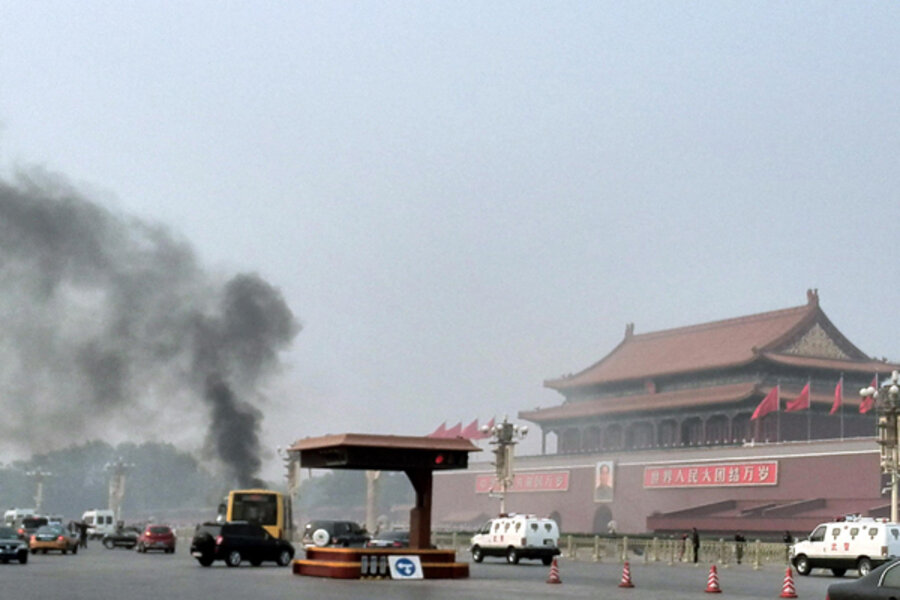SUV plows into Tiananmen Square: attack or accident?
Loading...
| Beijing
A sport utility vehicle plowed through crowds of tourists, then crashed and burst into flames in front of the Tiananmen Gate in central Beijing on Monday, killing the car's three occupants and two bystanders and injuring 38 others, police said.
It was one of the most dramatic incidents at the most politically sensitive spot in China since soldiers used deadly force to put down a student protest in Tiananmen Square in 1989.
It was not immediately apparent whether Monday’s fiery crash, directly in front of the portrait of Mao Zedong that hangs outside the entrance to the Forbidden City, was a deliberate attack or an accident.
Nobody had claimed responsibility for the incident by Monday evening. But the manner in which the car drove for several hundred yards along a sidewalk, according to eyewitnesses, suggested that it may have been deliberate.
The Chinese authorities released only the bare minimum of details and censors sought to delete pictures and discussion of the event. Police and firemen cleared Tiananmen Square within minutes of the fire breaking out just after noon, and erected screens in front of the burned out hulk of the SUV while they cleaned up the area.
Within two hours, traffic was back to normal.
A Philippine tourist, interviewed by China's Southern Metropolis Daily, said she heard the car’s horn sounding just before she lost consciousness. She found herself lying on the ground near the burning car when she came round.
One Philippine woman and a Chinese citizen from the southern province of Guangdong were among the dead, police said. They have not identified the three people reportedly traveling in the car that caught fire and who are said to have died.
Some social media users suggested that the incident might have been an intentional case of self-immolation. Around 120 Tibetans have set fire to themselves in the past four years in and around Tibet to protest what they see as Beijing’s oppressive rule; but none of them have killed or injured other people by their actions.
State TV did not mention the incident on its flagship 7 p.m. news show; Foreign Ministry spokeswoman Hua Chunying said she did not know the specifics of the case and could not say whether it was a terrorist attack or not.
Tiananmen Square, the highly symbolic heart of Chinese political power, is kept under very tight security. Fire extinguishers are kept on the square, and have been used in the past to put out fires by people seeking to immolate themselves.
In 2011 a man set himself alight very near where the car crashed Monday against the marble balustrade of the entrance to the Forbidden City. Policemen extinguished the man, who survived.
In 2009 three people set themselves and their car on fire on a shopping street a mile or so up the road from Tiananmen Square, apparently as a protest; in 2000 several hundred members of the Falun Gong spiritual movement forced the closure of Tiananmen Square on China's National Day and in 2001 five Falun Gong members tried to immolate themselves in the square.
In 1982 a female taxi driver who had been fined for not fulfilling her quota of fares drove her vehicle into a crowd at the entrance to the Forbidden City, killing five people. She was executed three weeks later.








